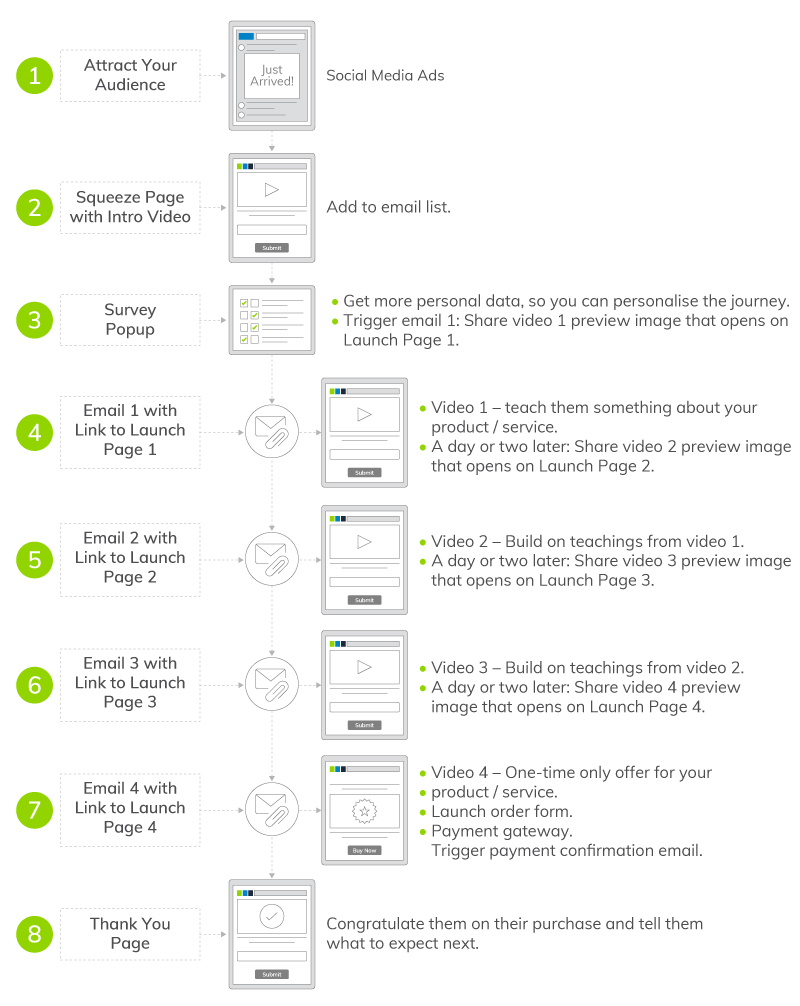Launching a new deal, product, brand, or service is always exciting. For us in marketing, a successful launch is all about the marketing strategy. In our marketing guide, How to Drive Conversions Using Automated Marketing Funnels, we explore using email automation with an online funnel model based on the Sideways Sales Letter. Here’s what you need to build one for yourself:

What is a Sideways Sales Letter?
The Sideways Sales Letter is a communication strategy created by Jeff Walker, the author of Launch and the creator of the Product Launch Formula. It takes a traditional sales letter and turns it on its side: sharing it as a story over time and ending with an irresistible offer for prospects to purchase. When you build this into an automated online funnel, you get something like this:

Why Use a Sideways Sales Letter?
In our marketing funnels guide, we explain the psychological principle of a Yes Ladder. It suggests that, by getting someone to say yes to smaller asks first, you warm them up to saying yes to bigger asks later. The Sideways Sales Letter provides similar value in that it delivers what would otherwise be a long sales letter into smaller, easier-to-digest chunks of information, increasing engagement and improving your chances of conversion at the end.
Launching with a Sideways Sales Letter also provides you with the value of storytelling; another powerful way of keeping people engaged. By weaving your sales letter into a journey with a beginning, middle, and end, you’re more likely to keep readers interested than with one bulky sales letter alone.
Sideways Sales Letter Email Strategy
Lean Labs says one of the reasons that putting a Sideways Sales Letter into an email series is so successful is because of the mental triggers you can use in the emails to get readers to convert. Persuasion principles like these include:
- Authority: Position yourself as an expert in your field.
- Sense of community: Share content that encourages interaction and makes prospects feel like they’re part of something just by being there.
- Reciprocity: Give leads content that they need and want; the more value you provide, the more they’ll want to reciprocate.
- Anticipation: Give prospects the sense that something even better is coming.
- Scarcity: Give leads a sense of urgency to buy by putting a time or volume limit on your offer.

There are multiple ways to go about compiling a series like this – how you do it will largely depend on your business and the offer. With the above principles in mind, Lean Labs recommends including the following emails in your Sideways Sales Letter email series:
Email 1: Authority – Address a Prospect’s Pain Points
Once you’ve enticed a prospect to sign up via your squeeze page (a landing page designed to collect visitors’ contact details), respond immediately with the first email using an engaging subject line. In the email, demonstrate that you’re an authority in your field using a content piece or, preferably, a video preview image that links to a video on a landing page.
Speak to pain points that the prospects have – showing your authority by the way you understand their problems and why they’re happening. Lastly, give them a teaser about the following email, so they’re intrigued about what’s to come.
Email 2: Reciprocity & Community – Share Your Solution
Now that subscribers have been introduced to the product or service you’re launching and they know that you understand their problem, start sharing the solution that your offer can provide.
Video is usually engaging, so if you can put these together for each email, great. Alternatively, you can use a short intro video filmed with your phone as a lead-in to the rest of the email. How ever you go about it, aim for engaging copy and subject lines.
Offer something juicy in this email; something of value, like a report or PDF guide. This should engage the behaviour trigger of reciprocity in subscribers. Additionally, you can introduce the mental trigger of community by inviting them to join your social media groups or to comment on your video.

Email 3: Anticipation – Reiterate That You Can Solve Their Problem
You’ve given them value and you’ve told them about your solution. Now it’s time to really drive that home by getting them excited about what it’s going to be like when you solve their problem. You can use emotional marketing for this. Lean Labs also recommends that you include a bulleted list of how your solution will solve their problem. This way, they can see at a glance, the impact you’ll have in their lives or their business.
Email 4: Scarcity – Reveal the Deal & Limit its Availability
This is where you share your offer and the way that subscribers can purchase it. To sweeten the deal or introduce a sense of urgency, consider releasing it for a limited time, or providing extra perks for the first 500 buyers (or whatever number of buyers works for your business).
The Sideways Sales Funnel is a great way to launch a new product, brand, or service online. With this structure and a strong creative team for copy and design, it can help you get prospects as excited about it as you are – improving conversions.
Want to learn how you can use landing pages and email automation to create other sales funnels for your business? Check out our guide, How to Drive Conversions Using Automated Marketing Funnels. In it, we explore how you can use funnels to:
- Establish a robust online presence that’s dynamic and flexible.
- Generate more leads automatically.
- Nurture leads using psychological principles.
- Make more sales.
- Automate some sales processes.
- Build a sustainable business marketing strategy.









